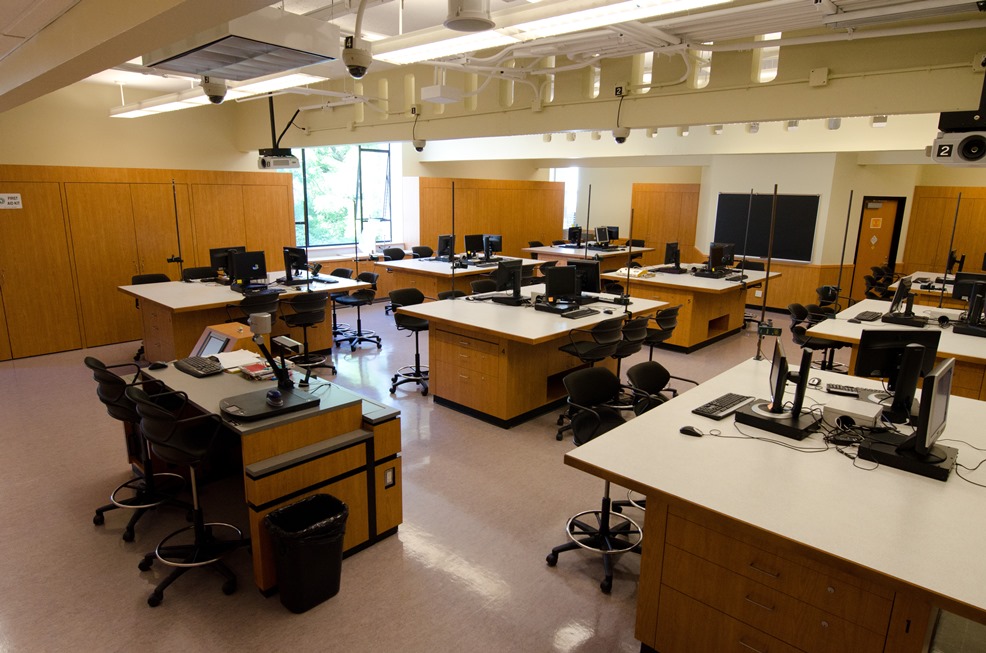Physics 100 Laboratory - The New Lab Design
Our new lab design focuses on doing authentic science in the real world, i.e. students gain experience and confidence with conducting scientific investigations while the outcome of an experiment is not known a priori. The overall goal of the lab is for students to be able to design and carry out an experiment, analyze the given data, determine uncertainties, and present their findings to their peers. The lab has two main parts: In the first eight weeks of the term, we build up a “scientific toolbox” in weekly 1.5-hour-long sessions. The last four weeks are dedicated to a final lab project, in which students perform an experiment at home (in pairs) with everyday equipment, analyze their data with the tools they have learned in class, and present their results to instructors and peers in form of a poster.
The sessions in the first eight weeks focus on understanding experimental data and uncertainty. The first lab assumes very little prior knowledge and subsequent labs build on the preceding labs thus slowly building up students’ skills from week to week. For example, in the first lab students are introduced to the concept of uncertainty and why repeated measurements are useful. The second lab follows up with visualizing uncertainties with histograms. In later labs, students use spreadsheet software (Excel, OpenOffice) on their own computers to determine the standard deviation of their data.
In our labs, students experience how experiments are designed to answer research questions and they are challenged to think about questions such as “how many data points should I take?” and “what are the sources of uncertainty in my experiment?”. Students use familiar equipment such as rulers and stopwatches for most experiments and some experiments are performed at home with typical household items (e.g. string and set of keys to build a simple pendulum). We deliberately avoid complicated equipment and complex procedures and there is no explicit attempt to enhance understanding of physics concepts – the focus is on understanding the concepts of measurement. For instance, students measure the average speed of a paper plane they build themselves. In other cases, the lab is motivated by a research question such as “How long will it take the model parachute to fall from a height of 2.0 m?” Here, students can perform measurements in the range (0.3 – 1.0) m and use their data to predict the outcome at 2.0 m. Consecutive labs are connected by homework (~ 30 minutes): students are asked to perform a relatively simple experiment at home and bring their data to the next lab session, or they are asked to perform further data analysis at home which is then discussed in the next session. In addition to experimentation, the labs feature class discussions using clickers, small-group discussions, and inquiry activities to help students make sense of their newly-acquired scientific toolbox.
After the completion of the first eight lab sessions, students are asked to choose a research question they want to investigate in their final project. Students may choose a non-physics topic such as “the relationship between shoe size and height by gender” as the scientific skills they acquire in the lab are not limited to physics. Students often choose questions that are closer to their interest, such as “do dark coats make one warmer than light coats?” The final projects are presented in a poster session at the end of the term.
The final project also serves as the main assessment of the lab. The quality is graded by teaching assistants using detailed rubrics and most points are given for the data analysis and for clear data presentation in tables, graphs, and histograms. During the first 8 weeks, students are assessed only on effort. In-class participation (clickers, worksheets) and lab homework are characterized very broadly as sufficient, borderline, or insufficient, using rubrics. In addition, the teaching assistants provide general feedback on the homework at the start of each session and discuss ways to improve the home experiments or clarify errors in the data analysis. We found that this assessment strategy works well; the students seem to understand that their engagement in the first half of the term is essential for success in their project.
The lab worksheets are posted below.